 Miscellaneous
Miscellaneous  Miscellaneous
Miscellaneous  Animals
Animals 10 Strange Attempts to Smuggle Animals
 Travel
Travel 10 Natural Rock Formations That Will Make You Do a Double Take
 Movies and TV
Movies and TV 10 Actors Hidden in Your Favorite Movies
 Our World
Our World 10 Science Facts That Will Change How You Look at the World
 Pop Culture
Pop Culture 10 Incredible Female Comic Book Artists
 Crime
Crime 10 Terrifying Serial Killers from Centuries Ago
 Technology
Technology 10 Hilariously Over-Engineered Solutions to Simple Problems
 Miscellaneous
Miscellaneous 10 Ironic News Stories Straight out of an Alanis Morissette Song
 Politics
Politics 10 Lesser-Known Far-Right Groups of the 21st Century
 Miscellaneous
Miscellaneous 10 Undeniable Signs That People’s Views of Mushrooms Are Changing
 Animals
Animals 10 Strange Attempts to Smuggle Animals
 Travel
Travel 10 Natural Rock Formations That Will Make You Do a Double Take
Who's Behind Listverse?

Jamie Frater
Head Editor
Jamie founded Listverse due to an insatiable desire to share fascinating, obscure, and bizarre facts. He has been a guest speaker on numerous national radio and television stations and is a five time published author.
More About Us Movies and TV
Movies and TV 10 Actors Hidden in Your Favorite Movies
 Our World
Our World 10 Science Facts That Will Change How You Look at the World
 Pop Culture
Pop Culture 10 Incredible Female Comic Book Artists
 Crime
Crime 10 Terrifying Serial Killers from Centuries Ago
 Technology
Technology 10 Hilariously Over-Engineered Solutions to Simple Problems
 Miscellaneous
Miscellaneous 10 Ironic News Stories Straight out of an Alanis Morissette Song
 Politics
Politics 10 Lesser-Known Far-Right Groups of the 21st Century
10 Dark Facts About Ritual Cannibalism
When most people hear the word cannibalism, they will likely imagine the literal consumption of human flesh by a fellow human. However, ritual cannibalism of the ancient world is something entirely different although no less intriguing, or indeed grim.
SEE ALSO: 10 Gruesome Cases Of Cannibalism In Modern-Day America
While it is a notion that is disputed by many and certainly divides opinion in several fields of interest, there are plenty of interesting points to examine. What’s more, these points are far reaching and stretch into several different areas of interest, not least the very foundation of the modern church.
Here are ten such points, each of which we should note are highly speculative ideas and theories, to say the least. They are, though, beyond intriguing, with enough circumstantial evidence for them to be relevant.
10 Fr Berenger Sauniere’s Death And Ceremony
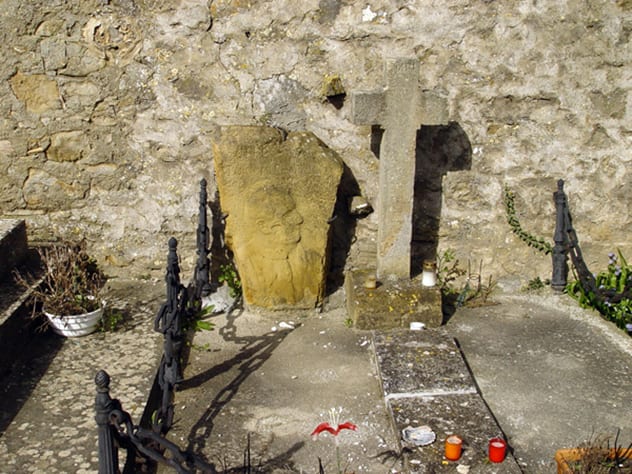
Perhaps the best place to start with our look at the claims of ritual cannibalism would be with the, strange unto itself, death of Berenger Saunier, a one-time poverty stricken priest who had taken over the small chapel at Rennes-le-Chateau in France in the early 1880s and suddenly became extremely wealthy seemingly out of nowhere and overnight. He would pass away suddenly from a stroke (despite being in perfect health) in the summer of 1917. What made his death even more intriguing was a visit from a nearby priest to administer the last rites in his final hours. Following an apparent confession from Sauniere, though, the priest refused to carry on and, unshriven, Sauniere died the next day.
The day after his death things took an even stranger turn when his body was carried on to the roof of the building, wrapped in a bright red garment with tassels hanging from the sleeves. A small group of mysterious mourners then arrived and would take turns to pass by his corpse, plucking and taking one of the tassels as they did so. Most researchers who examined this strange ceremony in the later years of the twentieth century were at a loss as to how to explain these bizarre events.
However, in his book “The Food of the Gods: Psychoactive Plants and the Cults of the Dead”, researcher, Earl Lee would offer an explanation that what the macabre ritual represented was, in fact, ritual cannibalism, and the tassels represented psychoactive mushrooms which, in ancient times, were grown on the bodies of the “blessed dead” – essentially, leaders and holy people of the community. This takes us neatly to our next point.[1]
9 The Jesus Connection
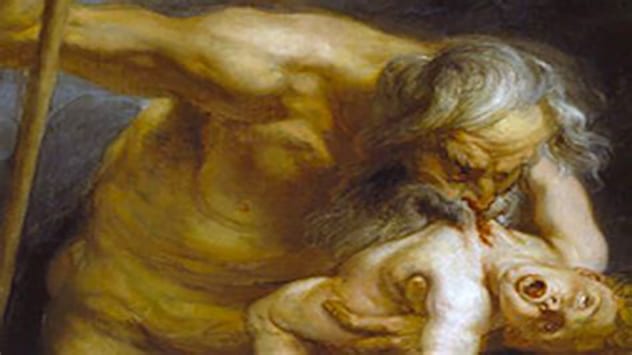
To be blunt, according to some researchers into the realities of ritual cannibalism Jesus – the real Jesus – was not attempting to start a new religion during his time. He was actually – at least according to the claims – attempting to reestablish the gnostic-type rituals of (even then) ancient times – where psychoactive mushrooms were grown on the corpses of the Blessed Dead – often using oils and liquified flesh laced with mushroom spores of corpses – which when eaten at rituals and specific ceremonies and festivals, would create a connection between the living and the dead. A “divine” connection!
It is perhaps worth considering the line from the Gospel of Thomas which says, “He who drinks from my mouth will become as I am, and I shall be he!”
Furthermore, even the use of anointing with sacred oil, certainly in light of such claims of ritual cannibalism should be examined and perhaps interpreted in a different way. In fact, further proof of this very specific preparation might reside inside the chapel once presided over by Sauniere.[2]
8 The 14th Station of the Cross
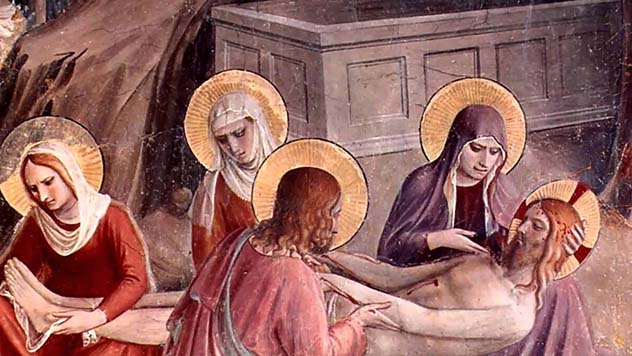
The 14th Station of the Cross appears to show the followers of Jesus removing his body from the tomb following his death due to the crucifixion. Researchers have suggested that the scene appears to take place at night, which was a clue to the fact that Jesus was actually alive when the scene took place as Jewish law forbids contact with the dead after dark.
However, it could very well be the case that Jesus was indeed dead, but that his followers were not concerned with Jewish law. The 14th Station might actually show – and also contribute toward, albeit circumstantially proving Saunier’s secret discovery – that Jesus and his followers were actually observing the ancient rites and rituals of ritual cannibalism.
We know, for example, there was an extraordinary amount of preparation with certain oils and spices with Jesus’ body. Might these have been in preparation for the growing of mushrooms upon the corpse, as well as the eventual collection of bodily, and to the followers, sacred fluids to be used in future ceremonies?
It is admittedly an unpalatable thought to most. It would, though, explain the enormity of Sauniere’s secret had this been the content of it. It would also explain the otherwise irrational behavior of the priest who refused to administer the last rites to the dying priest of Rennes-le-Chateau. As well as the seemingly equally irrational ceremony that took place with Saunier’s corpse the following day.[3]
7 The Opening Of The Mouth Ceremony
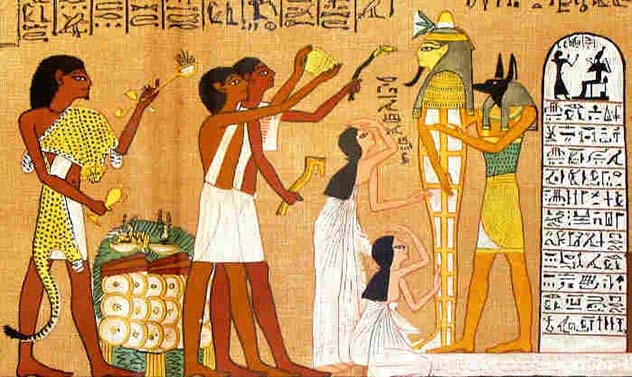
We should make it clear right from the top here that the vast majority of mainstream scholars and researchers reject the connection between the Opening of the Mouth ceremony from ancient Egypt and ritual cannibalism. However, author, Earl Lee would suggest that as well as the opening of the mouth so that the corpse and more specifically the soul within it “becomes Osiris” and begins its journey into the next life, it also gave those conducting the ceremony the chance to collect many of the bodily oils and liquefied flesh in order that they could add this to mushroom spore-heavy oils, as well as honey, for use in further ceremonies and rituals.
Quite often, this mushroom-spore spiked oils of the dead would be used to grow mushrooms on corpses, which would feed on the decaying flesh. Much like many of the other ancient civilizations – at least the hierarchy of the “priest kings” and shamans whose visions were so important for the rest of the community – eating such mushrooms and spiked oils would not only have an immediate reaction which was seen as connecting with the spirit world (especially when such produce was further spiked with cannabis and opium) but it also allowed the wisdom and the essence of the dead persons soul to enter those who consume them.
Indeed, it might be worth remembering again the quote of Jesus once more – “He who drinks from my mouth will become as I am, and I shall be he!”[4]
6 Ritual Cannibalism In Minoan Culture
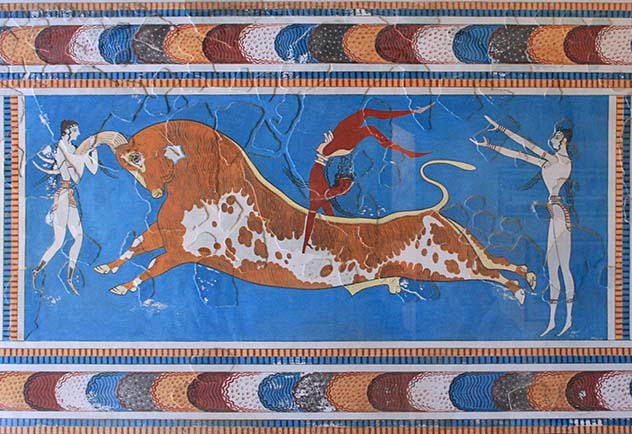
It certainly wasn’t only the ancient Egyptians or the ancient tribes and civilizations in and around the Palestine regions in the centuries BC who were indulging in such ancient ritual cannibalism. We will explore one of the more (relatively speaking) recent European connections in our next point. But perhaps one of the other civilizations with relatively clear examples of ritual ancient cannibalism as highlighted in the examples above would be the Minoans.
Indeed, in a similar way to the alleged Opening of the Mouth ceremony connections discussed above, it is believed by some researchers that not only would the Minoans use the corpses of the leading dead upon their natural death for such ritual purposes, they would often use human sacrifice in order to collect such liquefied flesh and bodily oils which were then used to grow mushrooms on other corpses, but also was used in honey – which itself preserved such mushrooms – in order to assist it in fermenting and eventually turning into mead.
Even the way these sacrifices were killed was in such a way so as to avoid bloodletting – they were often heaving drugged and likely strangled or suffocated. Immediately following death they would have every orifice sealed shut by wax in order to hurry the liquifying process of the internal flesh.
Many round buildings with a central pit have been discovered in the region which were seemingly used to assist in this decaying process of the corpses. This shape of building will come back up shortly in a later point.[5]
5 The Knights Templar and The Cathars
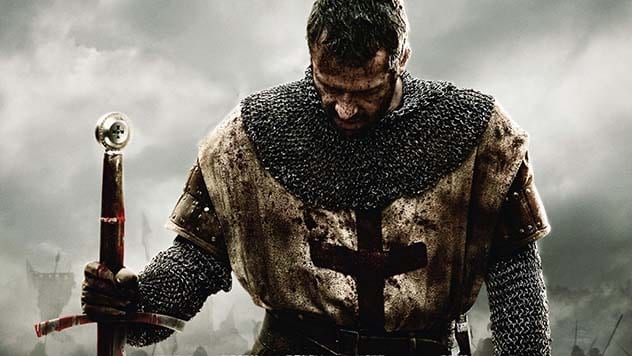
Perhaps one of the more recent communities to practice such methods of ritual cannibalism, at least according to some, are the Cathars, who interestingly enough, in the twelfth and thirteenth centuries resided in what is now the modern-day southern regions of France. And interestingly enough, given the Cathars claims to follow the true message of Jesus, is said to be the place where Mary Magdalene arrived – possibly with Jesus – following the crucifixion in Jerusalem, and where she resided until her death, and where the bloodline of Jesus continued from.
This region of France was also heavily populated with Knights Templar properties at the same time as the Cathars. And while this could quite possibly be nothing more than coincidence, when we examine the inner workings of the Knights Templar, as well as their apparent “real reason” for setting up the safe passage for the crusades, it is certainly an interesting connection. When we then examine our next point, bearing in mind the, albeit unofficial, connections between the leading hierarchy of the Templar Knights and what would later become known as Freemasonry, that connection becomes even more interesting.[6]
4 The Ultimate Secret Of Freemasonry
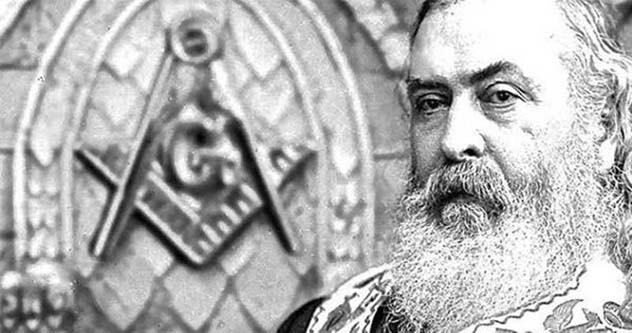
Whether there is a connection between the Knights Templar and Freemasonry is a debate in itself. However, in relation to the secrets of ancient ritual cannibalism and the whether such rituals were observed, if only symbolically by both organizations, it is perhaps worth examining an alleged incident involving one of the leading Freemasons of all time, Albert Pike.
It is said that upon learning the “ultimate secret” of Freemasonry – which is said to be the realization that the true God is a combination of three deities – Pike went into an uncontrollable rage, refusing to accept such a thing.
Whereas Pike was said to be a “devout Christian”, many of his actions suggest otherwise. We have to ask if this suggestion really would make the leading Freemason react in such a way. Or might it be, again as speculative as it is, that the ultimate secret was that of the “divine” food of the gods and their cannibalistic nature sent Pike into such a rage?[7]
3 Red Paste On Many Ancient Corpses

Over the many decades or archaeology and the study of ancient history the persistent discovery of “red corpses” (seemingly bones stained red and even red mummified remains) is something that they have by and large collectively been unable to explain.
However, it would appear that these discoveries are another indication of ancient ritual cannibalism. Many researchers state that red is the traditional color of death in the ancient world. Not only do we have the apparent red garment worn by Berenger Sauniere, who we began our list with, but in more recent times, the funeral of the pope featured red as the prime color of the event.
What’s more, aside from the apparent symbolic connection of red, the pastes and clay mixtures used would often aid in “sealing shut” the body so that – in the same way that the wax sealing achieved in the Minoan practices – the body essentially became a “sack or bag” that would then aid in the purification of the flesh. This, like our next point suggests not only widespread use, but seemingly shared and widespread knowledge.[8]
2 Round Huts A Sign Of Widespread Practice
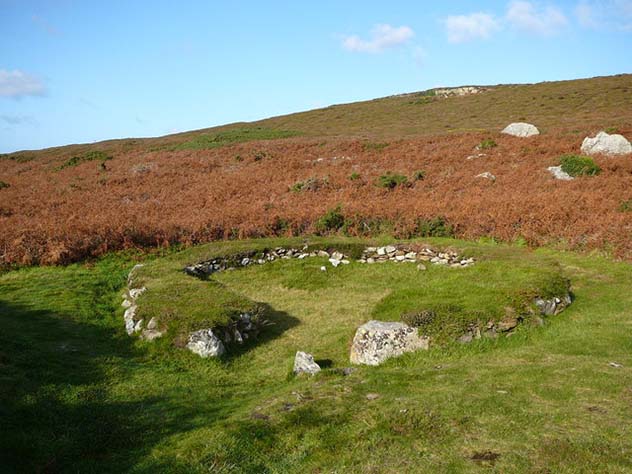
Many of the corpses were stored in purposely built round stone “huts” (similar to those of the Minoan civilization) where they would be left to “liquify” for several weeks. Following this, they would be relieved of their bodily fluids as detailed above. What is perhaps intriguing, then, is that these strange round buildings – or at least the remains of them – are to be found all across Europe and indeed in various places right across the planet.
Many of these buildings would have had clay roofs in their contemporary era, possibly in an effort to trap the heat and speed up such fermenting and liquefying processes.
This has to make us ask just how far spread this dark practice actually was in antiquity? And how far back it might have gone before details of such rituals begin to show in the historical record? And how such knowledge of these practices was passed on to these seemingly unconnected and isolated civilizations?[9]
1 10,000-Year-Old Cave Painting Featuring Shaman And Mushrooms
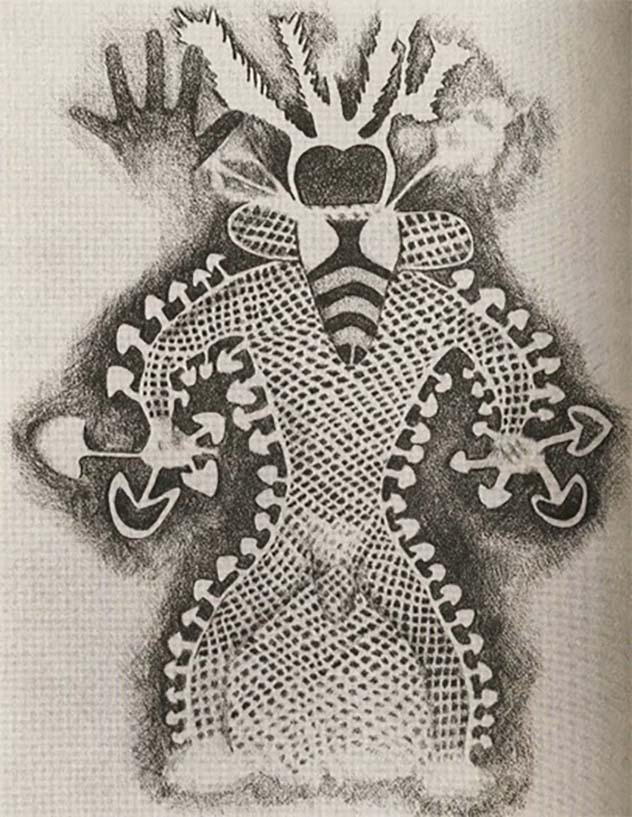
There is much documentation of these practices, but much is subject to interpretation. However, one particular cave painting in the Algerian mountains is of particular interest to researchers of ancient ritual cannibalism. Not least as it appears to show a shaman priest with what appears to be a beehive on his head (remember the preservation qualities of the honey) and what appear to be dozens of mushrooms all over his body.
Many dismiss the literal meanings of the painting. However, some researchers, not least the likes of the previously mentioned Earl Lee, suggest we should take such cave art is a literal meaning.
To paraphrase Lee’s explanation, for example, a shaman priest very likely died and was buried in a shallow grave wearing a garment that was – intentionally or not – laced with mushroom spores. When the body was discovered and mushrooms discovered and consumed, their psychoactive properties were taken as a divine experience and a connection with their lost shaman priest.
From this event, as extremely speculative as it is, is likely where the beginnings of the ritual cannibalism began in antiquity, eventually spreading to the lands of Egypt and Palestine and then, if not already being practiced, throughout most of Europe (as we have seen, many of the round “corpse huts” are present as far as Great Britain).[10]
For more creepy lists like this one, take a look at 10 Animals With Cannibalistic Sex Habits, and 10 Facts About Human Cannibalism From Modern Science.
About The Author: Marcus Lowth—writer at Me Time For The Mind—https://www.metimeforthemind.com/
Me Time For The Mind on Facebook—https://www.facebook.com/MeTimeForTheMind/






![9 Sinister Facts About The Dark Side Of Instagram [WARNING: Disturbing] 9 Sinister Facts About The Dark Side Of Instagram [WARNING: Disturbing]](https://listverse.com/wp-content/uploads/2019/10/proxy.duckduckgo-150x150.jpg)
![Top 10 Dark Facts About The Death Penalty [DISTURBING] Top 10 Dark Facts About The Death Penalty [DISTURBING]](https://listverse.com/wp-content/uploads/2020/06/deathpenalty-150x150.jpg)
